What is a Cash Receipt form?
A Cash Receipt form is a document used to record the receipt of cash payments. It serves as proof of payment for both the payer and the recipient. This form typically includes details such as the date of the transaction, the amount received, the purpose of the payment, and the names of both parties involved. It helps maintain clear financial records for businesses and individuals alike.
When should I use a Cash Receipt form?
You should use a Cash Receipt form whenever you receive cash payments. This could be for services rendered, sales transactions, or any other situation where cash changes hands. Using this form ensures that you have a reliable record of the transaction, which can be helpful for accounting and tax purposes.
How do I fill out a Cash Receipt form?
Filling out a Cash Receipt form is straightforward. Start by entering the date of the transaction. Next, write the name of the person or business making the payment. Then, specify the amount received and describe the reason for the payment. Finally, both parties should sign the form to acknowledge the transaction. Keep a copy for your records.
Can I create my own Cash Receipt form?
Yes, you can create your own Cash Receipt form. Just ensure it includes all the necessary details, such as the date, payer's name, amount, purpose, and signatures. Many templates are available online if you prefer to use a pre-made version. Customizing a form can also help meet your specific needs.
Is a Cash Receipt form legally binding?
A Cash Receipt form is generally considered a legal document. It serves as evidence of a transaction and can be used in disputes if necessary. However, the enforceability may depend on the completeness of the information provided and the context of the transaction. Always keep accurate records to support your claims.
What should I do with the Cash Receipt form after it’s filled out?
After filling out the Cash Receipt form, both parties should keep a copy for their records. This helps maintain accurate financial documentation. Store the forms in a safe place, as they may be needed for future reference, tax filings, or in case of any disputes related to the transaction.
